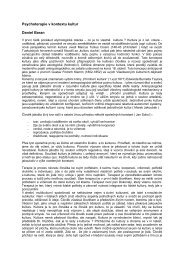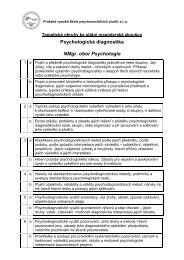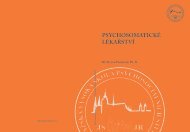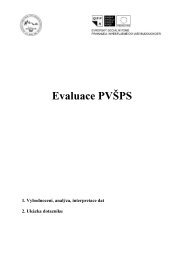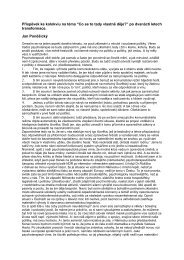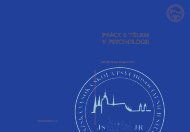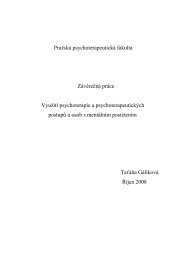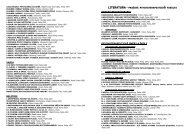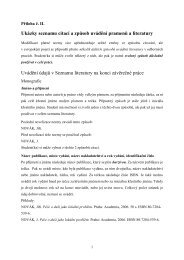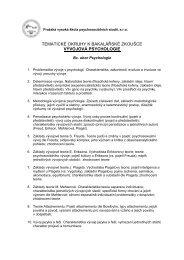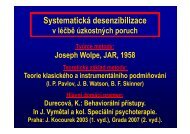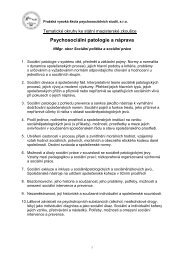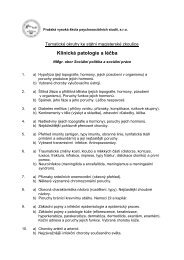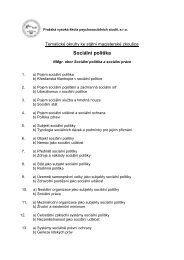New Sources of Fear in a Late Modern Society: The Globalization of ...
New Sources of Fear in a Late Modern Society: The Globalization of ...
New Sources of Fear in a Late Modern Society: The Globalization of ...
You also want an ePaper? Increase the reach of your titles
YUMPU automatically turns print PDFs into web optimized ePapers that Google loves.
110<br />
NEW SOURCES OF FEAR IN A LATE MODERN SOCIETY<br />
While study<strong>in</strong>g how people cope with fear, a particularly strong situational context<br />
expresses itself: “Situational contexts may have different potentials to activate<br />
either repressive or defensive cop<strong>in</strong>g. For example, ma<strong>in</strong> effects <strong>of</strong> defensiveness<br />
may be expected especially <strong>in</strong> situations <strong>in</strong> which the motive to avoid social disapproval<br />
is more strongly activated than the motive to avoid negative affect” (Pauls<br />
& Stemmler 2003, p. 286). <strong>The</strong> <strong>in</strong>dividual can make use <strong>of</strong> a varied, <strong>of</strong>ten mutually<br />
compet<strong>in</strong>g, arsenal <strong>of</strong> cop<strong>in</strong>g strategies, which are used differently <strong>in</strong> an <strong>in</strong>trapersonal<br />
(private) and <strong>in</strong>terpersonal (public) context: “Repressors <strong>in</strong> the public condition<br />
thought and worried about the partner’s (bad) impression <strong>of</strong> them, whereas<br />
the nonrepressors were unaffected by the favorability <strong>of</strong> the evaluation or <strong>of</strong> the<br />
public nature <strong>of</strong> the situation. ... Repressors prefer an avoidant self-deceiv<strong>in</strong>g strategy<br />
when they receive negative feedback privately, but when self-image-threaten<strong>in</strong>g<br />
<strong>in</strong>formation is public knowledge, they pay close attention to it, th<strong>in</strong>k about possible<br />
refutations, and rum<strong>in</strong>ate particularly about how other people perceive them. ...<br />
Repressive–defensive copers compared with other personality groups showed highbehavioral<br />
and low self-reported negative affect” (Pauls & Stemmler, 2003, p. 298).<br />
An <strong>in</strong>spir<strong>in</strong>g study <strong>of</strong> the effectiveness <strong>of</strong> fear appeals directed towards the<br />
prevention <strong>of</strong> various k<strong>in</strong>ds <strong>of</strong> risky behavior (e. g. dr<strong>in</strong>k<strong>in</strong>g and driv<strong>in</strong>g) demonstrates,<br />
unlike predom<strong>in</strong>ant thought, the differences between the effectiveness<br />
<strong>of</strong> prevention campaigns based on high-efficacy fear appeals: “It was the lowefficacy<br />
condition that proved most beneficial <strong>in</strong> divert<strong>in</strong>g attention away from<br />
alcohol-related advertis<strong>in</strong>g. In fact, the high-efficacy fear appeal proved counterproductive<br />
to prevention-based efforts <strong>in</strong> that it caused process<strong>in</strong>g resources to be<br />
drawn toward alcohol-related advertis<strong>in</strong>g” (Nielsen & Shapiro, 2009, p. 268).<br />
THE ORIGINS OF CONTEMPORARY FEAR<br />
<strong>The</strong> follow<strong>in</strong>g text presents fear primarily from a sociological perspective and<br />
focuses on the mapp<strong>in</strong>g <strong>of</strong> the socio-cultural causes <strong>of</strong> fear, specifically the nam<strong>in</strong>g<br />
<strong>of</strong> relevant fear stimuli as risks and reveals their orig<strong>in</strong>s <strong>in</strong> the contemporary<br />
Western society. Giddens (2000) notes that for a majority <strong>of</strong> the populace, life <strong>in</strong><br />
medieval Europe was dangerous, cruel and short (similar to conditions <strong>in</strong> many<br />
<strong>of</strong> the poor countries <strong>in</strong> today’s world). Nonetheless, what is notable is that <strong>in</strong> the<br />
Middle Ages, the concept <strong>of</strong> risk factors (similarly to many traditional cultures)<br />
was absent. Dur<strong>in</strong>g the 16 th and 17 th centuries risk was associated with unmapped<br />
territory dur<strong>in</strong>g exploratory expeditions that sailed around the globe. <strong>Late</strong>r, a connection<br />
began be<strong>in</strong>g made with time, just as it is used <strong>in</strong> bank<strong>in</strong>g and <strong>in</strong>vestment,<br />
where the calculation <strong>of</strong> potential outcomes <strong>of</strong> <strong>in</strong>vestment decisions is a key factor<br />
<strong>in</strong> the subsequent actions. As Giddens (2000) po<strong>in</strong>ts out, <strong>in</strong> the ensu<strong>in</strong>g years, this



